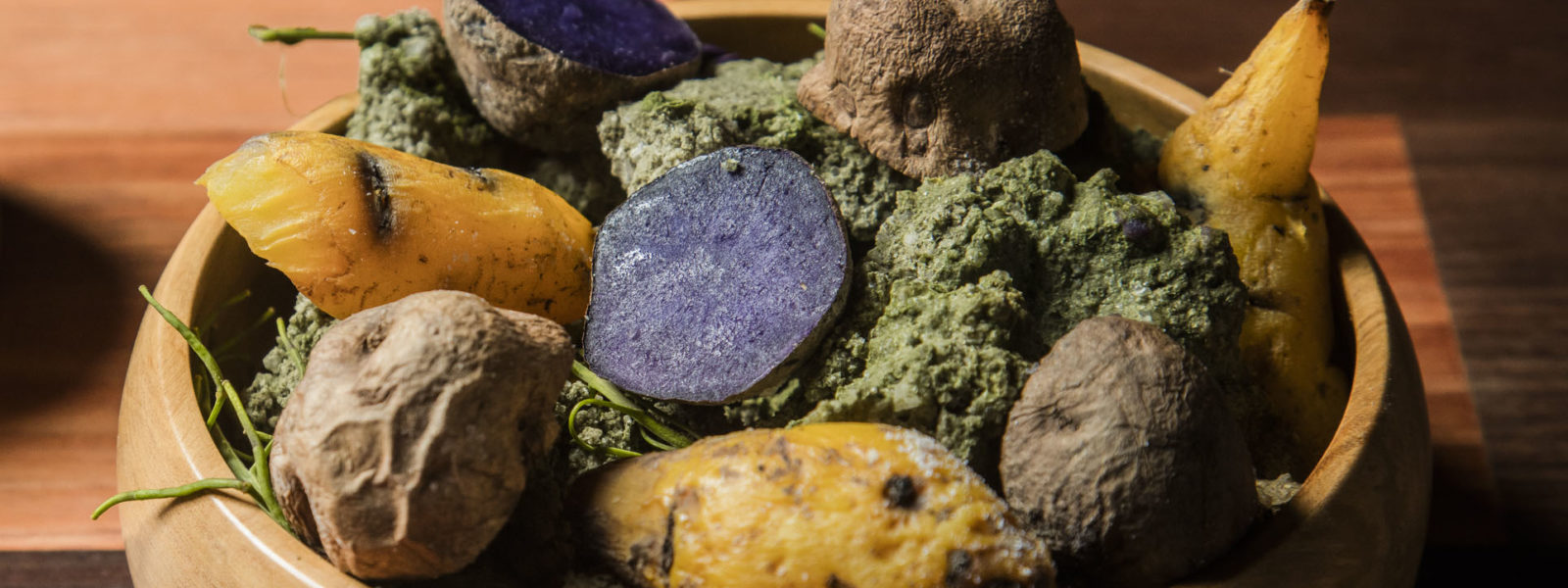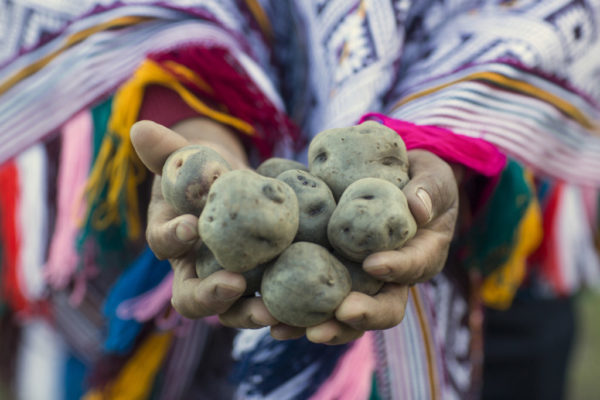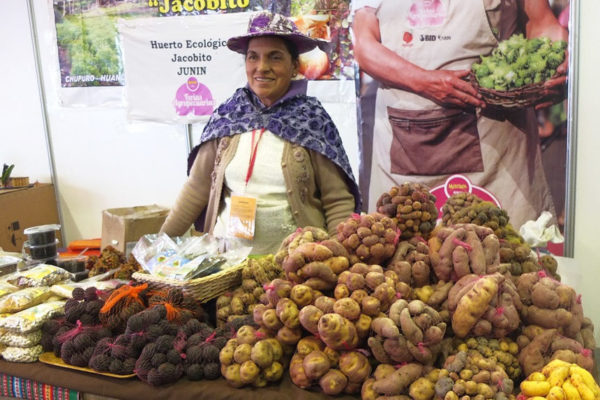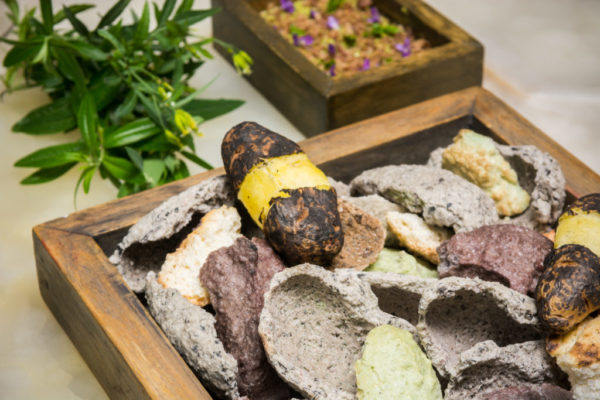Roots, tubers and bananas are often seen as “traditional” foods. Yet their colors and flavors vary, and they can be exciting gastronomic ingredients, as well as healthy functional foods. However, despite their many benefits, they tend to fall out of favor as people move to towns and diets change to “modern” and perhaps more convenient foods. Typically, traditional staple foods lack a spokesperson or voice, while industrially processed products are widely promoted through advertising campaigns. That lowers demand for traditional staples and can impact the livelihoods of smallholder growers who produce them. But what can be done to change perceptions?
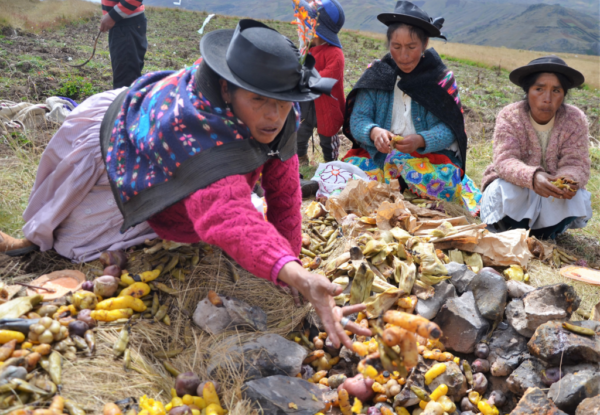
Women prepare a colorful harvest of native Andean roots and tubers which vary in texture and flavor, making them exciting gastronomical ingredients. Photo: S.DeHaan/CIP
Around 15 years ago, researchers at the International Potato Center (CIP) had the idea to work with top chefs and gastronomy schools in Peru to enhance demand for native potatoes. Here, with more than 3,000 varieties, the country’s native potato biodiversity is the largest in the world, yet farmers growing them often lived in poverty. The idea harnessed the power of gastronomy and influential chefs to shift perceptions about native potatoes, which were not valued as important foods and not well known in urban markets.
“The Participatory Market Chain Approach (PMCA) was used to engage farmers and other value chain actors including supermarkets to promote innovation of a range of new products, including colored chips made from native potatoes which were sold to urban consumers, tourists and through export markets. While fresh native potatoes as a gourmet new product were sold in supermarkets,” says André Devaux, Latin American and the Caribbean Regional Director for CIP, who pioneered the approach.
“We worked with the chefs to show them the huge diversity of native potatoes available, to try out new dishes and to promote native potatoes in new venues such as the Mistura gastronomy fair in the capital Lima,” adds Devaux.
Native potatoes became one of the star products in the new Novo Andino Cuisine, leading to a marked increase in demand for native potatoes in Peru with benefits for farmers through higher prices. Innovation proved to be a crucial component of the approach – creating new products from well-known but neglected crops.
Building on this success, CIP researchers have recently begun to reach out to a new wave of restaurants in Peru, including the world-renowned Central Restaurant through its research group Mater Iniciativa. Chef Virgilio Martinez designed a special 10-dish tasting menu of potatoes which was shared in a session on culinary innovation during the World Potato Congress earlier in the year in Cusco, Peru. Gonzalo Urbina of Mater Iniciativa explained that “cuisine is the point of intersection of biodiversity and society, so it can play a key role in the revalorization of Andean products and the creation of social value. We are excited to work with CIP in this area.”
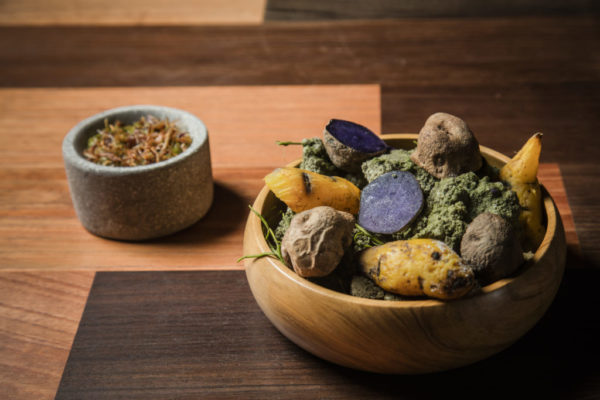
A dish prepared using native potatoes served at Virgilio’s restaurant ‘Mil’. Photo: Central Restaurant
At the World Potato Congress session, Chef Marcia Taha of the Gustu restaurant in Bolivia also presented novel culinary innovation developed from native potatoes and other Andean crops. The Gustu initiative is linked to broader transformative culinary education through the Manq’a schools. Manq’a, or “food” in the Aymara language in this region, is a project of cooking schools that seeks to generate life opportunities for young Bolivians with the revaluation and consumption of local products.
The power of culinary innovation has also been harnessed elsewhere, including in Japan where the consumption of indigenous sweetpotato was declining.

Sweetpotato custard pudding topped with dried sweetpotato is one of many innovative dishes developed in Mie, Japan.
“In Mie, Japan, there was a very successful case for transforming the image of indigenous sweetpotato, called Kinkoimo. Before the project, the indigenous sweetpotato was just dried and consumed locally as a snack. However, the younger generation had no interest in the product, which they regarded as “uncool”. The market demand declined sharply,” explains Nozomi Kawarazuka, CIP social scientist.
“To transform its image, a project was established by municipal government, farmers organization, university researchers, chefs and package designers, and utilizing social and traditional media. The dried sweetpotato was then turned into products and now it is viewed as a cool and fancy food,” she adds.
Transforming the image of the crop brought multiple benefits to the community including increased incomes and more tourists. “Most importantly, farmers became proud of their produce,” says Kawarazuka.
A trained chef, Kawarazuka is further embracing the power of gastronomy by teaming up with Graham Thiele, Director, CGIAR Research Program on Roots, Tubers and Bananas (RTB) to create a series of cooking videos using RTB crops. Through the videos the pair hope to share dishes across cultures and demonstrate that RTB crops are global foods that are staples in traditional dishes worldwide. The first three videos in the series feature the chefs speaking Swahili while preparing patacones – a Latin America snack of fried plantain fritters, sanguche de chicharron – a Peruvian dish made from pork, sweetpotato and bread), and potato samosas.
Indeed charismatic chefs have played central roles in shaping the images of a crop, but the difficulty lies in disseminating the image beyond the restaurant to wider populations.
“Culinary innovation can be more sustainable if various stakeholders are involved early on. While chefs play a key role, they are also less connected with producers. Agricultural research organizations can bridge relationships between farmers and restaurants, and with the private sectors and governments which can provide financial resources to sustain and scale up,” explains Kawarazuka.
As shown in countries as far apart as Peru and Japan, culinary innovation can play a critical role in changing the perceptions of urban consumers around the use and value of root, tuber and banana crops. Creating an enabling environment for value chain interventions means that the market can scale innovations, leading to sustained livelihood benefits for small-scale farmers.
